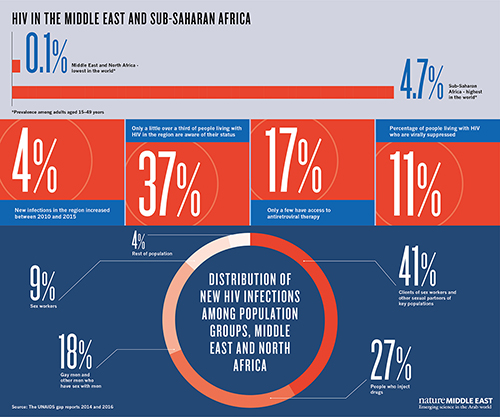Using AI to control energy for indoor agriculture
30 September 2024
Published online 1 December 2016
On this World AIDS Day, the Arab world has to remember that despite having a low prevalence of HIV and AIDS, prevention efforts need to be dramatically scaled up.

But the Arab world and North Africa (as the infograph on the right shows) remain very far from some of these targets.
In fact, the outlook is very bleak for instance in terms of disease awareness and access to care; a whopping 63% are unaware of their HIV status. And only 17% receive antiretroviral therapy.
HIV remains highly stigmatized.
The 2016 UNAIDS prevention gap report1 for adults showed that in the Middle East and North Africa, annual new HIV infections increased by 4% between 2010 and 2015. According to the report, 96% of new HIV infections happen among what experts call "key populations," which are predominantly people who inject drugs, men who have sex with men and female sex workers and their sexual partners.
There's also a huge funding gap between what's needed and what's being offered by local governments and public services across the Arab world; men who have sex with men and sex workers specifically rarely receive support.
For this reality to change, nationwide policies have to cater to HIV and AIDS healthcare needs, and strive to reach those most at risk; the policies need to be in sync with international targets and the UNAIDS Sustainable Development Goals, which aims to end the AIDS epidemic by 2030. So far, 35 million have died from AIDS-related illnesses since the first cases of HIV were reported.
Perhaps the Arab world should also take a leaf out of the 90-90-90 targets programme set by the US Agency for International Development, which already runs various programmes in the Middle East, including in Egypt. The international agency hopes that in four years 90% of all people living with HIV will know their HIV status, 90% with diagnosed HIV infection will receive sustained antiretroviral therapy, and 90% of those receiving antiretroviral therapy will have viral suppression.
doi:10.1038/nmiddleeast.2016.215
Stay connected: